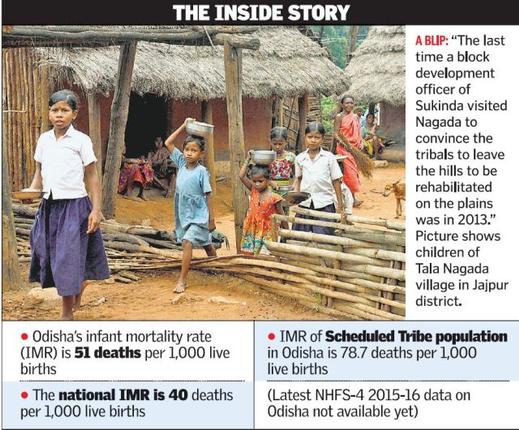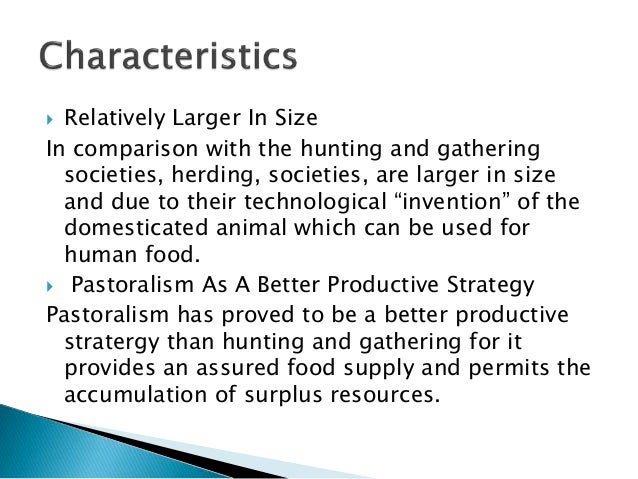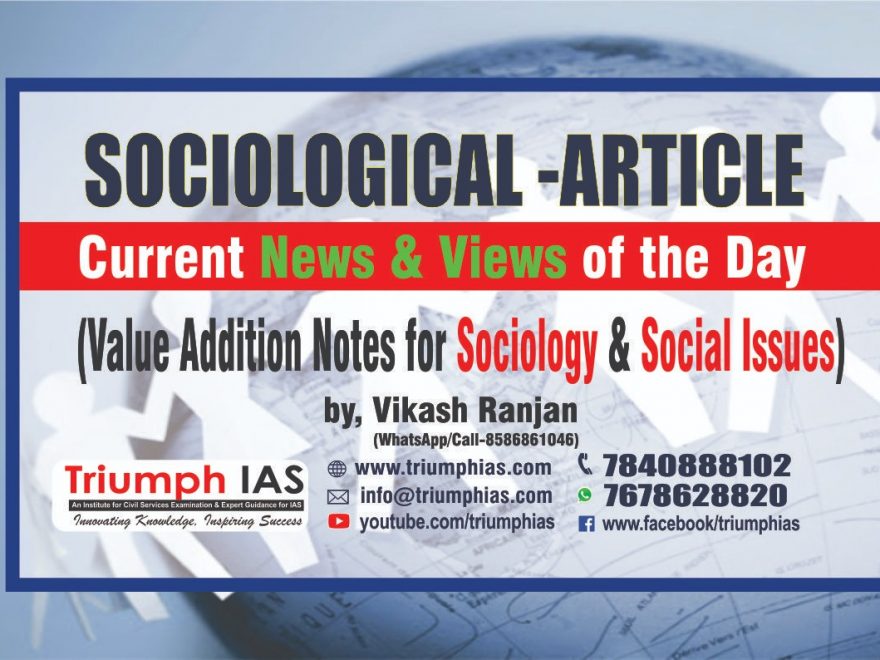Tribes in India: Tribals in Nagada suffer from severe malnutrition, other health issues
Relevance: Sociology: (iii) Tribal communities in India:(a) Definitional problems. (b) Geographical spread. (c) Colonial policies and tribes. (d) Issues of integration and autonomy. & G.S paper I: Society and Social Issues & G.S paper II: Vulnerable sections in the society.
CONTEXT

World Health Day 2020: How nutrition gardens helped tribals in Odisha’s Nagada
There are approximately 582 people who belong to the Juang tribe in Odisha’s Nagada. This tribe is one of the 13 particularly vulnerable tribal groups in the state.
Nagada is a cluster of hamlets, located at Mahagiri mountain range in Odisha’s Jajpur, about 94 kilometres away from district headquarters.
One of the main reasons why Nagada remained untouched by development over the years was its inaccessibility.
Government outreach services were unable reach inhabitants of this cluster because it was in a remote area with poor infrastructure, including a lack of roads.
Tribals in Nagada suffered from severe malnutrition and other health issues as a result. The village lacked basic amenities needed for survival.
Nagada made headlines in July 2016, when 19 children died from severe malnourishment within a month. The state government immediately took action to not only address malnutrition, but also improve issues of infrastructure development.
Metal roads were constructed, ponds were excavated, electricity was brought in, anganwadis were made and houses were constructed under the Pradhan Mantri Gramin Awaas Yojana.
The government also focused its attention on enhancing the livelihoods of the community, providing nutritious food to children under the age of six years and more through different line departments and social assistance schemes.
The Odisha Livelihoods Mission (OLM) also took instant action to address the needs of the community.
The Odisha government and OLM felt that a focused intervention was needed to create an enabling environment for the overall well-being of the people in Nagada.
This called for combining strategies for immediate and long-term intervention, with non-profit Trickle Up chosen as a partner by OLM to lead the initiative.
Trickle Up realised that while food security could be ensured for poor households in Nagada through the public distribution system, it was not enough for overall development of the mind and body.
Food diversity was required to receive wholesome nutrition and develop to a person’s full potential.
This was absolutely critical for pregnant mothers, lactating mothers and for children below six years of age.
The community in Nagada lacked the resources and proper awareness to ensure food diversity and optimum intake of nutritious food.
The Solution
The Trickle Up team working in Odisha faced this challenge by deciding to implement what is known to be one of the best solutions to tackle the difficult issue of malnourishment: The creation of nutrition gardens for families.
The promotion of nutrition gardens can reduce 70 per cent of the diseases caused by deficiency of vitamin A, according to a survey by the Food and Agriculture Organization in 2011.
A nutrition garden appropriately utilises space at the front and rear ends of a house to grow fruits and vegetables that can not only sustain the family, but also support their dietary requirements.
Seasonal vegetables are grown by utilising locally available waste and other materials as manure or fertiliser. They can be used for long periods to fulfill the daily needs of the household.
Approximately 60 households from Nagada adopted the practice of having a nutrition garden in their household during the kharif season, while 34 households adopted this practice during the rabi season.
Azim Premji Philanthropic Initiatives supported training needs to start and maintain the gardens. They also supported the procurement of seeds. These gardens ensure regular supply of the required amount of nutritious vegetables to the families.
A new addition to the behaviour change process was the introduction of the food festival in the community.
During this festival, the community is encouraged to cook together and eat together, while the field staff demonstrates new and nutritious ways to cook and eat papaya and yam – the abundantly available local produce that the community is not used to eating.
The initiative aims to add to the nutrition value of the food, while changing eating habits.
These processes have not just contributed to behaviour change, but also initiated healthy habits into the system of community living in Nagada.
Nutrition gardens encourage the optimisation of locally available resources for communities that stay in areas with fewer resources and limited connectivity.
The aim of Trickle Up is to have nutrition gardens throughout the year so that it actively contributes in reducing malnourishment rates in the community.
SOCIOLOGICAL PERSPECTIVE

CONCEPTUALIZING TRIBALS
Social fonnation of India has mainly three components – tribal settlements, villages and towns. It is difficult to draw sharp distinction amongst them because they share some common characteristics. But one thing appears to be true that the tribes have been exploited economically and socially by the nontribals living in tribal area.

Article 46 of India’s constitution says: “The State shall promote with special care the educational and economic interests of the weaker sections of the people, and, in particular, of the Schedule Castes and the Schedule Tribes and shall protect them from social injustice and all fonns of exploitation.”
But there are tribes who have remained outside the schedule list of constitution and fonn weaker sections of India’s population. The tribes are backward particularly in the fields of education and economy and have been exploited by the dominant sections of Indian society such as landlords, money-lenders and industrialists who have grabbed their lands by various means.
Tribes have generally been defined in India in tenns of what they are not. They did not practice a religion with a written text, did not have clear class divisions, did not have a state or political form of the normal kind and most importantly they did not have caste. The term was introduced in the British period more for the purpose of administrative convenience.
David Mandelbaum points out that ‘In tribal life the principal links for the whole society are based on kinship’. Kinship is not simply a principle of social organization; it is also a principle of inheritance, division of labour and distribution of power and privileges. Mostly tribal societies are small in scale. They possess a morality, religion and world view of their own, corresponding to their social relations.
APPROACHES TO THE TRlBALS: ISOLATION, ASSIMILATION, INTEGRATION AND OTHERS
Tribals in India have always been the source of study for Sociologists and Anthropologists both Indian and foreign.
They have been treated differently by different scholars depending upon their individual background, experience and interest. There has always been difference of opinion regarding suitable model for the integration of the tribals to the mainstream of Indian life.
To start with, the officers of the census of lndia, till the year 1931, forcefully stick to the point that the tribals were distinct from non-tribals as far as religion is concerned. They made the point clear that the tribals were animist and the non-tribals were not. G.S. Ghurye (1959) contested this by remarking that the tribals have never been markedly different from the neighbouring non-tribes. Ghurye theory states that the so called ‘aborigines’ in India share the culture and language of the non-aboriginal Hindu communities of the respective region they live in.
This view is shared and supported by the scholars such as Aiyappan(1960), Majumdar(1950) and even K.S.Mathur (1972).
J.H.Hutton, as quoted by G.S. Ghurye (1959: 150), was mild supporter of isolationism. He clearly pointed out the evils imported upon the tribals by the British rule.
To a large extent, O’Malley (1908) also extended his support to the fmdings of Hutton. He opined that history of the tribal people during their British contact was a somewhat distressing record of the effects of an alien civilization impinging on simple and backward people.
It must be noted here that both Hutton and O’Malley pleaded for the policy isolationism but in lower key.

The assimilation of tribal people with the rest of the population has been a continuous process and for it culture contact with the neighbouring population is held responsible. The tribal people in India have come in contact with different Hindu and other communities and there have been different degrees of culture contact leading to assimilation in different areas. This culture contact has given rise to so many types of tribals and has created a set of different types of tribes on acculturation level. Classification by Ghurye (1959), Majumdar (1947), Dube (1960) reveal that the process of assimilation has been a part of and parcel of the Indian culture.
CONCLUSION
On the basis of different approaches adopted by the anthropologists such as G.S. Ghurye(1959), N.K.Bose(1929), D.N.Majumdar(1950), V.Elvin(1944), Haimendorf (1960), F.G.Bailey (1960), S.L.Doshi (1978) , we can conclude that the tribal problem has been viewed at two levels – structural and conflict. The Structuralists are of the opinion that tribal backwardness is relative and the tribals have been the victims of exploitation.
They could be brought in the mainstream structures of the society as independent citizens rather than domesticated subordinates. But those who analyze tribal society from a special historical sense hold the view that any model for tribal absorption should not be based on caste syndrome instead be based on class lines. Their incorporation in the national mainstream should be viewed within the framework of the means of production and production relations.
For more such notes, Articles, News & Views Join our Telegram Channel.
Click the link below to see the details about the UPSC –Civils courses offered by Triumph IAS. https://triumphias.com/pages-all-courses.php

